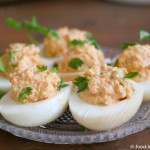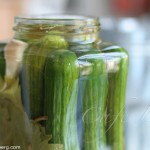
It can make a grown man cry.
There’s nothing like a good, homemade horseradish to give you the kind of kick you can’t find in store-bought jars, probably because the manufacturers fear sending their customers running in the other direction. But if you ask me, the entire point of horseradish is that it’s spicy — incredibly, unbelievably spicy.
My homemade horseradish was a huge hit at last year’s seder with friends. The first bite made them curse, scream and turn red, but then they went back for more. And more. In fact, they ate it all.
In fact, it’s always a hit. All it takes is a few people brave enough to try it, and then everyone else wants to see if the horseradish is really as hot as they’re making it out to be.

Horseradish looks like an innocuous, mild-mannered root, and it’s been showing up in increasing quantities at the markets over the past month. But that innocence vanishes once you grind it up — exposure to air is what brings out the vengeance. Homemade ground horseradish is much more spicy than the shaved strips that some people serve at their seders, probably because of the extra surface area.
I’ve read recommendations to blend it outside, or at least in a well-ventilated space. And once it’s ground, part of the challenge is removing the lid from the blender in such a way that you won’t be too blinded by tears to keep on working. A gas mask wouldn’t be out of place here.
For some of us, though, the powerful fumes are a benefit, not a problem. The high point of my husband’s family’s seder is the horseradish-eating contest. I still haven’t figured out how you win, but I think it has something to do with whoever turns the reddest. After I’d ground up the horseradish, my lovely husband wanted nothing more than to stick in his nose into the blender and inhale. Once he recovered, he promptly called his siblings and informed them that he’d won the contest by default.
My husband aside, normal people who want to prepare horseradish are advised to peel and chop it while submerged in water, which controls exposure to air. I used a small 150-gram root, which is enough if you expect your guests to treat it as a condiment and not a side dish.
I then ground the pieces in the blender, without water. (Given that the last things in my blender were garlic and skhug, I wonder how my next milkshake will come out?) I then let it sit (covered) for 10 minutes, to give it extra air exposure. UPDATE: If you really want horseradish strong enough to kill a horse, letting it sit isn’t enough — detach the blender bowl, and making sure you’re holding the blender lid is firmly in place, shake like crazy. Repeat.
Adding water to the horseradish halts the heat development, while vinegar stabilizes the flavor. I added 3-4 tablespoons of water and a tablespoon of vinegar, and blended again, until the horseradish was pulpy.
If spicy is not your thing, add the water and vinegar to the blender immediately, instead of waiting. That should tone things down. You could also dilute your horseradish with some cooked beet.
Horseradish (a small bowl’s worth)
- ±150-200 grams horseradish root
- 3-4 tablespoons water
- 1 tablespoon vinegar
Prep time: 10 minutes
Chop and peel the horseradish while submerged in water.
For a spicy horseradish, drain the water and grind in the blender, and let sit for 10 minutes. For an even spicier horseradish, detach the blender bowl, hold the lid in place and shake well to incorporate even more air. Then blend in the 3-4 tablespoons water and vinegar.
For a milder horseradish, blend straightaway with the water and vinegar.
Optional: Add cooked beets for color or a milder flavor. Season with salt and sugar to taste.
For more on horseradish: A New York Times reporter grows it, grinds it and cries.




